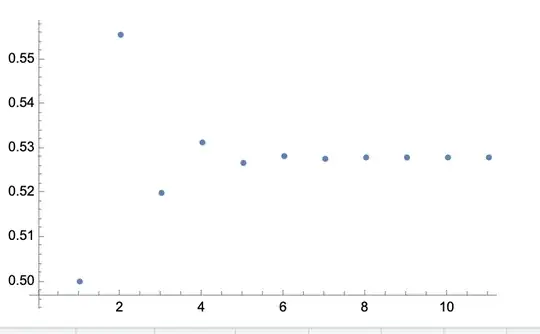TL;DR: For many channels, as the number $i$ of iterated applications of the channel grows, the state $T^i(\rho_0)$ converges to a fixed point of $T$. Then, the purity of $T^i(\rho_0)$ converges to the purity of a fixed point of $T$, not to an eigenvalue of its Choi matrix.
Example where purity is outside Choi spectrum
Let $\rho$ denote a quantum state with eigenvalues $p_1,\dots,p_d$ and define $\mathcal{C}_\rho(X):=\rho\,\mathrm{tr}(X)$, the state preparation channel for $\rho$. The purity of $\rho$ is $\gamma=\sum_ip_i^2$, but the eigenvalues of the Choi matrix $J(\mathcal{C}_\rho)$ coincide with those of $\rho$. But generally $\gamma\notin\{p_1,\dots,p_d\}$.
Contractive channels
By Banach fixed-point theorem quantum channels that are contractive maps, such as non-trivial depolarizing and amplitude damping channels, have exactly one fixed point $\rho_{\text{fix}}$. In this case, the purity of $T^i(\rho_0)$ tends to $\mathrm{tr}(\rho_{\text{fix}}^2)$ independently of the initial state.
Non-contractive channels
The situation is more complicated for non-contractive channels. If $T$ is non-contractive, then $T^i(\rho_0)$ may fail to converge, as happens in the case of the bit-flip channel acting on $|0\rangle$.
Nevertheless, by Schauder fixed-point theorem, every channel, contractive or otherwise, has at least one fixed-point. Moreover, when $T^i(\rho_0)$ does converge, then it necessarily converges to a fixed point$^1$. However, Banach fixed point theorem no longer applies and the fixed point may not be unique. For example, every point on the line connecting the poles of the Bloch sphere is a fixed point of the phase damping channel. In general, which fixed-point $T^i(\rho_0)$ converges to depends on $\rho_0$.
Non-contractive qubit channels
The situation is a little simpler if $T$ acts on a qubit and when $\rho_0$ is the maximally mixed state. In this case, if $T$ is non-contractive then the maximally mixed state $\frac{I}{2}$ is necessarily$^2$ among the fixed points of $T$. Therefore, the purity of $T^i\left(\frac{I}{2}\right)$ is $\frac12$.
$^1$ This can be deduced from the continuity argument similar to that in the proof of Banach fixed-point theorem:
$$
\rho_*=\lim_{i\to\infty}T^i(\rho_0)=T\left(\lim_{i\to\infty}T^{i-1}(\rho_0)\right)=T(\rho_*).
$$
$^2$ We can make a simple geometric argument. Suppose $T$ is non-contractive. For contradiction, it is sufficient to show that $T$ shrinks the trace distance between any pair of antipodal points. If $T$ displaces the center of the Bloch sphere $B(O,1)$ from $O$ to $A\ne O$, then more than half of the surface of the ball $B(A,1)$ lies outside of $B(O,1)$. However, the image $T(B(O,1))$ must lie within $B(A,1)$. Therefore, distance between any two antipodal points is necessarily reduced by the action of $T$.
